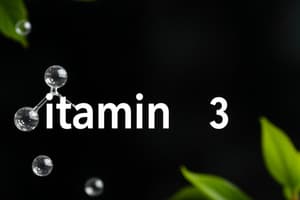Podcast
Questions and Answers
What is the primary function of 1,25-dihydroxycholecalciferol (1,25-[OH]2-D3)?
What is the primary function of 1,25-dihydroxycholecalciferol (1,25-[OH]2-D3)?
- To inhibit calcitonin secretion
- To increase calcium absorption in the intestine (correct)
- To decrease calcium absorption in the intestine
- To convert vitamin D3 into an inactive form
Which hormone is secreted in response to increased levels of calcium in the blood?
Which hormone is secreted in response to increased levels of calcium in the blood?
- Calcitriol
- Insulin
- Calcitonin (correct)
- Parathyroid hormone (PTH)
How is vitamin D3 activated in the body?
How is vitamin D3 activated in the body?
- It is directly absorbed from the diet
- It is secreted from the thyroid gland
- It is converted into calcitonin
- It undergoes hydroxylation in the kidney (correct)
What effect does calcitonin have on parathyroid hormone (PTH) activity?
What effect does calcitonin have on parathyroid hormone (PTH) activity?
What triggers the secretion of calcitonin?
What triggers the secretion of calcitonin?
Flashcards
Vitamin D3
Vitamin D3
A form of vitamin D that is produced in the skin by exposure to sunlight or obtained through the diet.
25-hydroxycholecalciferol (25-OH-D3)
25-hydroxycholecalciferol (25-OH-D3)
The inactive form of vitamin D that is produced in the liver from Vitamin D3.
1,25-dihydroxycholecalciferol (1,25-[OH]2-D3)
1,25-dihydroxycholecalciferol (1,25-[OH]2-D3)
The active form of vitamin D that is produced in the kidneys from 25-OH-D3. Its main function is to increase calcium absorption in the intestines.
Calcitonin
Calcitonin
Signup and view all the flashcards
Parathyroid hormone (PTH)
Parathyroid hormone (PTH)
Signup and view all the flashcards
Study Notes
Vitamin D3 Metabolism
- Vitamin D3 (cholecalciferol) is obtained from diet or sun exposure.
- The liver converts vitamin D3 to 25-hydroxycholecalciferol (25-OH-D3).
- 25-OH-D3 is an inactive form of vitamin D.
- The kidney hydroxylates 25-OH-D3 to 1,25-dihydroxycholecalciferol (1,25-[OH]2-D3), the active form.
- Active vitamin D increases calcium (Ca2+) absorption in the intestines.
- Active vitamin D enhances parathyroid hormone (PTH)'s effect on bone resorption.
Calcitonin
- Calcitonin is produced by the medullary cells of the thyroid gland.
- Calcitonin secretion occurs when blood calcium (Ca2+) levels rise.
- Calcitonin lowers blood calcium levels by inhibiting PTH and vitamin D.
- Calcitonin is not normally secreted for routine calcium regulation.
- It responds to high calcium (hypercalcemic) stimuli.
Studying That Suits You
Use AI to generate personalized quizzes and flashcards to suit your learning preferences.
Description
Explore the metabolism of Vitamin D3 and the role of Calcitonin in calcium regulation in this quiz. Learn how Vitamin D3 is converted into its active form and the physiological effects of both hormones on calcium levels in the body. Test your understanding of these essential biochemical processes.




